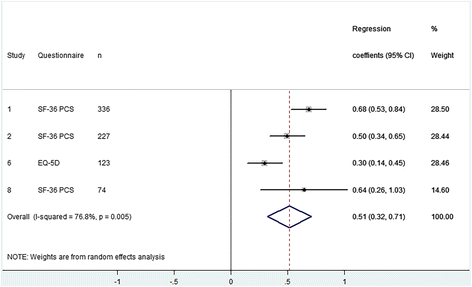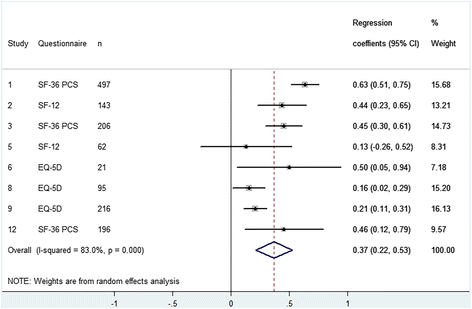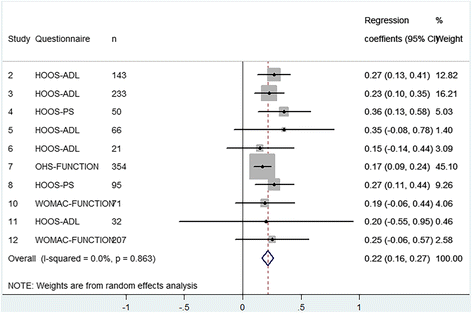The influence of preoperative determinants on quality of life, functioning and pain after total knee and hip replacement: a pooled analysis of Dutch cohorts
- PMID: 29499692
- PMCID: PMC5833034
- DOI: 10.1186/s12891-018-1991-0
The influence of preoperative determinants on quality of life, functioning and pain after total knee and hip replacement: a pooled analysis of Dutch cohorts
Abstract
Background: Previous research has identified preoperative determinants that predict health related quality of life (HRQoL), functioning and pain after total knee or hip arthroplasty (TKA/THA), but these differed between studies and had opposite directions. This may be due to lack of power and not adjusting for confounders. The present study aims to identify the preoperative determinants that influence health related quality of life (HRQoL), functioning and pain after total knee or hip arthroplasty (TKA/THA).
Methods: We pooled individual patient from 20 cohorts with OA patients data (n = 1783 TKA and n = 2400 THA) in the Netherlands. We examined the influence of age, gender, BMI and preoperative values of HRQoL, functioning and pain on postoperative status and total improvement. Linear mixed models were used to estimate the effect of each preoperative variable on a particular outcome for each cohort separately. These effects were pooled across cohorts using a random effects model.
Results: For each increase in preoperative point in HRQoL, the postoperative HRQoL increased by 0.51 points in TKA and 0.37 points in THA (SF-36 scale). Similarly, each point increase in preoperative functioning, resulted in a higher postoperative functioning of 0.31 (TKA) and 0.21 (THA) points (KOOS/HOOS-ADL scale). For pain this was 0.18 (TKA) and 0.15 (THA) points higher (KOOS/HOOS-pain scale) (higher means less pain). Even though patients with better preoperative values achieved better postoperative outcomes, their improvement was smaller. Women and patients with a higher BMI had more pain after a TKA and THA. Higher age and higher BMI was associated with lower postoperative HRQoL and functioning and more pain after a THA.
Conclusions: Patients with a better preoperative health status have better outcomes, but less improvement. Even though the independent effects may seem small, combined results of preoperative variables may result in larger effects on postoperative outcomes.
Keywords: Functioning; Pain; Postoperative; Preoperative; Quality of life; Total hip replacement; Total knee replacement.
Conflict of interest statement
Ethics approval and consent to participate
The Medical Ethical Committee of the Leiden University Medical Center (CME P15.043/SH/sh) confirmed on February 13 2015 that ethical approval for this type of study is not required under the Dutch Medical Research (Human Subjects) Act. The hospitals that supplied anonymous data obtained written informed consent from the study participants.
Consent for publication
Not applicable.
Competing interests
The authors declare that they have no competing interests.
Publisher’s Note
Springer Nature remains neutral with regard to jurisdictional claims in published maps and institutional affiliations.
Figures






References
-
- OECD . Health at a glance: Europe 2012. 2012. Hip and knee replacement.
-
- Otten R, van Roermund PM, Picavet HS. Trends in the number of knee and hip arthroplasties: considerably more knee and hip prostheses due to osteoarthritis in 2030. Ned Tijdschr Geneeskd. 2010;154:A1534. - PubMed
-
- Spooren A, van Steenbergen LN, Denissen GAW, van der Togt CR, van Rooden SM. LROI Report 2013 Insight into quality & safety. Den Bosch: Dutch Arthroplasty Register (LROI); 2013.
Publication types
MeSH terms
Grants and funding
LinkOut - more resources
Full Text Sources
Other Literature Sources

